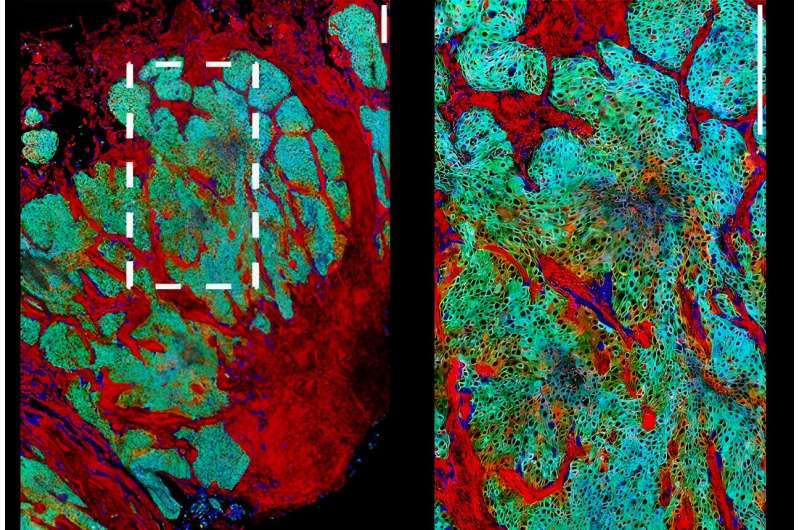This article has been reviewed according to Science X's editorial process and policies. Editors have highlighted the following attributes while ensuring the content's credibility:
fact-checked
peer-reviewed publication
trusted source
proofread
Scientists map the evolution of urinary tract cancer cells

Researchers at Weill Cornell Medicine have performed the most comprehensive analysis to date of cancer of the ureters or the urine-collection cavities in the kidney, known as upper tract urothelial carcinoma (UTUC). The study, which compared the characteristics of primary and metastatic tumors, provides new insights into the biology of these aggressive cancers and potential ways to treat them.
In the study, which appeared March 18 in Nature Communications, the researchers examined tissue samples from 44 primary and metastatic UTUC tumors. They compared gene mutations and gene activity patterns in these tumors and mapped cell types using a technology that can visualize protein surface markers at the single-cell resolution.
A key finding was that the basic molecular characteristics of these UTUC tumors—their molecular subtype—are mostly stable during the evolution from the primary to the metastatic stage. That suggests that oncologists treating UTUC patients may often be able to use analyses of primary tumor samples for molecular subtype-guided treatment of metastases.
"This dataset we generated provides unique insights into UTUC biology and should be an important resource for researchers and clinicians," said Dr. Juan Miguel Mosquera, a professor of pathology and laboratory medicine and director of research pathology in the Englander Institute for Precision Medicine at Weill Cornell Medicine.
Dr. Mosquera, who is also a member of the Sandra and Edward Meyer Cancer Center at Weill Cornell Medicine, co-led the study with Dr. Bishoy Faltas, an assistant professor of medicine and the Gellert Family-John P. Leonard, M.D. Research Scholar at Weill Cornell Medicine. The study's first author is Dr. Kentaro O'Hara, who was a postdoctoral research fellow in the Department of Pathology and Laboratory Medicine and in the Englander Institute for Precision Medicine when the study was conducted.
UTUC tumors are rare compared to bladder tumors, accounting for 5 to 10% of all urothelial cancers. They are also considered relatively aggressive, and metastatic UTUC tumors are particularly hard to treat successfully.
Previously, Dr. Faltas and colleagues illuminated the molecular details of primary UTUC tumors in a widely cited 2019 study. Much less has been known about the characteristics of metastatic tumors that have already spread to distant organs.
Building on this work, the researchers used DNA and RNA sequencing in the current study to map the gene mutations and gene activity patterns in the primary and metastatic samples. They also employed a newer technique called Imaging Mass Cytometry, which labels key surface proteins on individual cells in the samples, enabling detailed, cell-by-cell identification and spatial mapping of cell types.
"The Imaging Mass Cytometry allowed us for the first time to explore the spatial relationships between tumor cells and other cells such as immune cells that make up the UTUC tumor microenvironment," said Dr. Mosquera, who is also a pathologist at NewYork-Presbyterian/Weill Cornell Medical Center.
The 2019 study led by Dr. Faltas revealed that primary UTUC tumors usually belong to a particular molecular subtype that also features a relative absence of T cells—suggesting immune suppression in the tumor microenvironment. The new analysis confirmed this pattern and found that metastatic UTUC tumors in a given patient tended to have the same characteristics as the primary tumor.
"Frequently, we are unable to obtain sufficient biopsy tissue from metastatic tumors and have to rely on the molecular analysis of the primary tumor, so it's important to know that the molecular subtype based on RNA expression is generally stable from the primary to the metastatic stages," said Dr. Faltas, who is also director of bladder cancer research in the Englander Institute for Precision Medicine and a member of the Meyer Cancer Center at Weill Cornell Medicine, and an oncologist at NewYork-Presbyterian/Weill Cornell Medical Center.
"We were able to understand the contributions of different cell types to these molecular subtypes and how they evolve over the cancer's natural history by analyzing the protein expression of hundreds of thousands of single cells from these tumors."
The researchers also observed that metastatic UTUC tumor cells had genetic mutations not found in the primary tumors. These differences were much greater in patients undergoing chemotherapy, suggesting that chemotherapy may have induced some mutations.
The study sets the stage for highly personalized, molecularly-guided primary and metastatic UTUC treatment strategies to improve patient outcomes. The single-cell insights gained have the potential to accelerate the development of targeted therapies and immunomodulatory approaches and transform the landscape of UTUC management.
More information: Kentaro Ohara et al, The evolution of metastatic upper tract urothelial carcinoma through genomic-transcriptomic and single-cell protein markers analysis, Nature Communications (2024). DOI: 10.1038/s41467-024-46320-w , www.nature.com/articles/s41467-024-46320-w



















